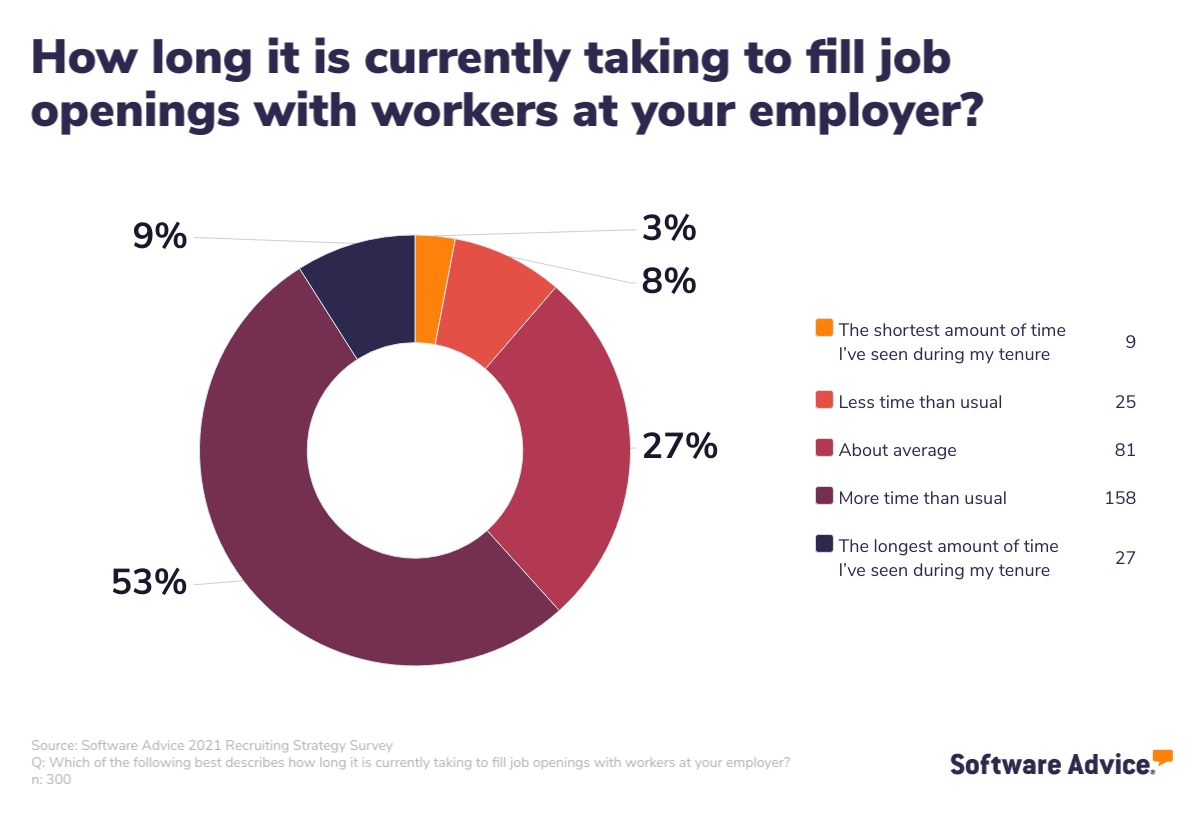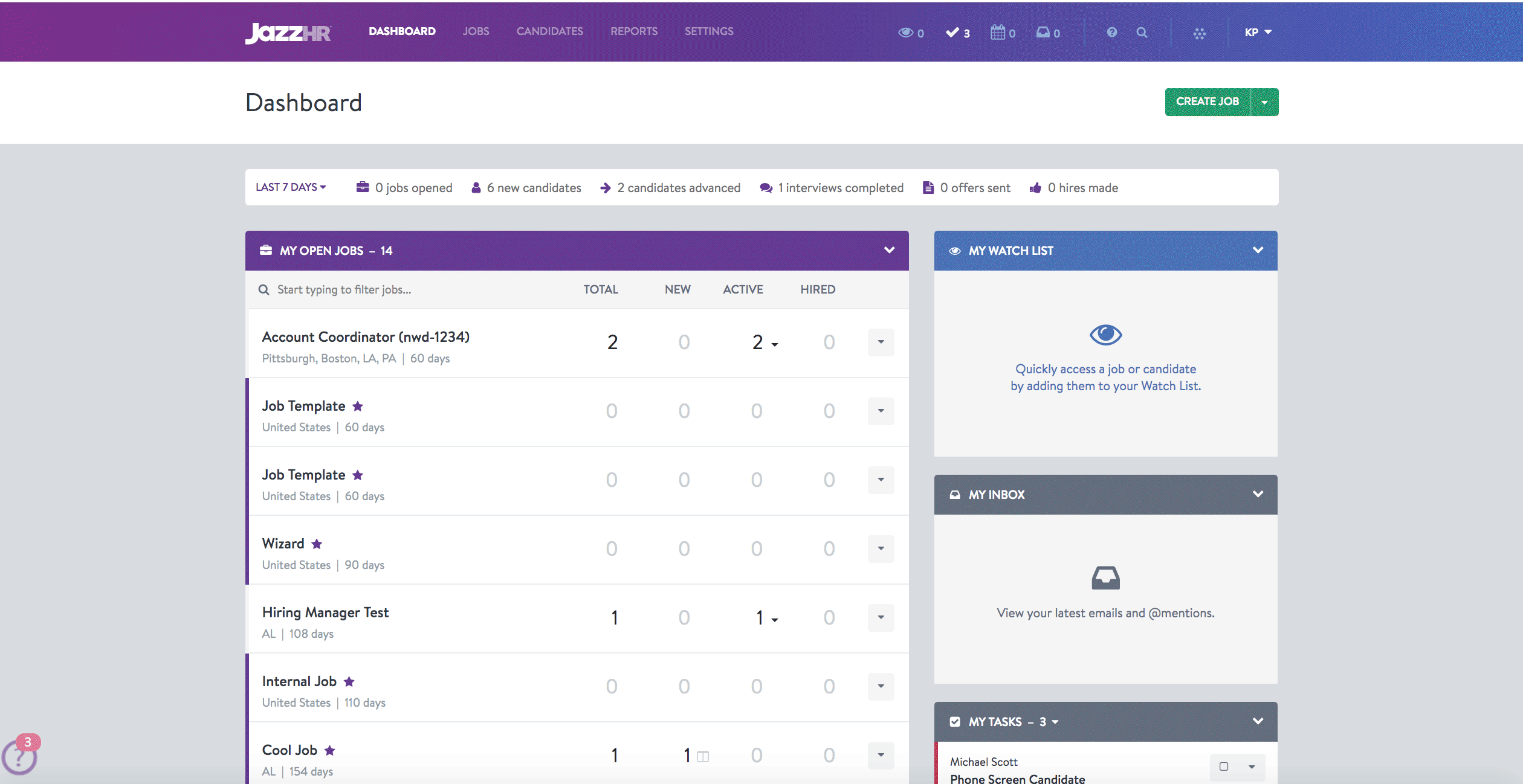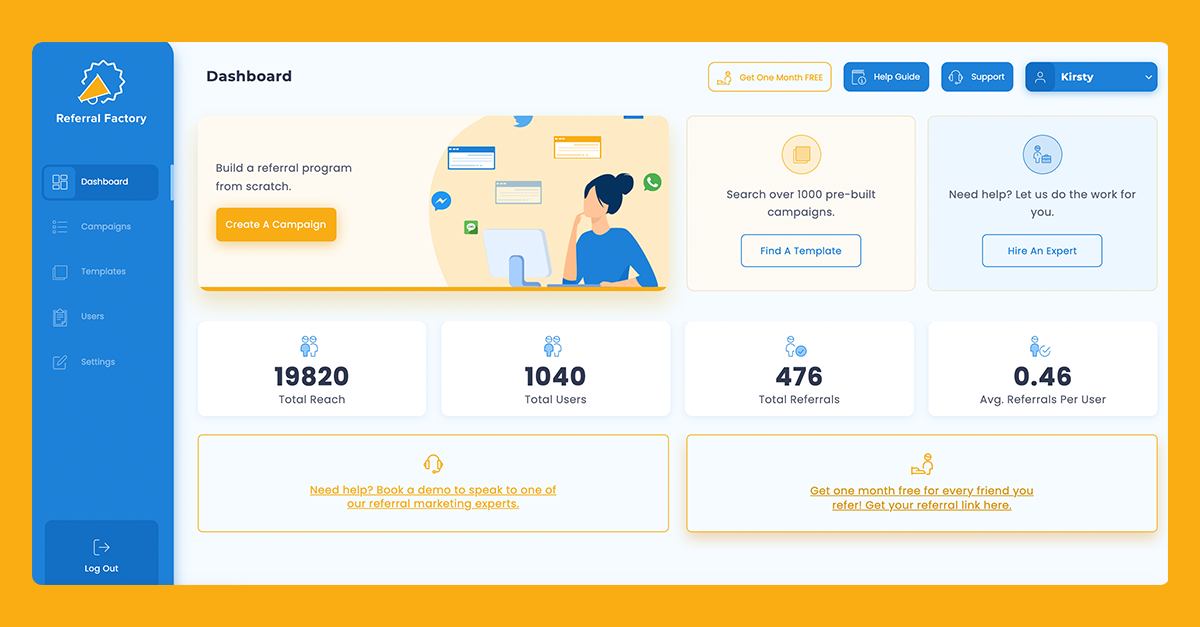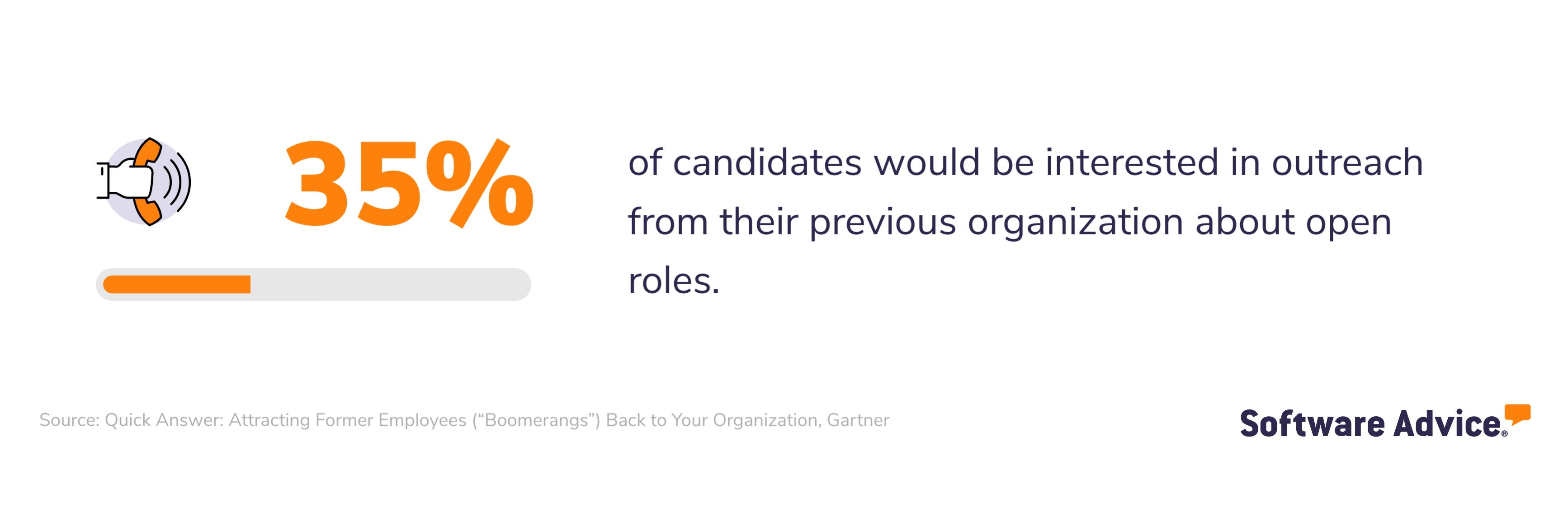Recruiting is Easier With Talent Pools—Here’s How To Build Your Own
Mục lục bài viết
Recruiting is Easier With Talent Pools—Here’s How To Build Your Own
By: Sierra Rogers on December 19, 2022
In 2021, Software Advice’s Recruiting Strategy* survey revealed that it was taking the majority (62%) of recruiters longer than average to fill open roles:

Unfortunately, it doesn’t seem to be getting easier any time soon; in Q3 of 2022, Gartner reported that 50% of organizations still expect the competition for talent to increase significantly in the next six months [1].
If you’re a hiring manager or recruiter who’s feeling the pressure, and you haven’t yet developed a talent pool for your organization, now is the time to. Talent pools help alleviate the challenges of talent acquisition (such as finding qualified candidates), and you’re in luck, because with the help of Gartner research [1], we’ve put together this four-step guide for building a talent pool.
Let’s start with the basics: What is a talent pool?
A talent pool is a network of candidates recruiters frequently engage with. Candidates in talent pools are sourced from a variety of places, including previous applications, employee referrals, and networking events. Talent pools typically exist in the form of a searchable database, usually within an applicant tracking system or recruiting platform.
Why are talent pools important for recruiters?
The primary benefit of developing and managing a talent pool for businesses is that it can lead to a lower time to fill for recruiters. In fact, Gartner reports that hiring managers who spend less time on decision-making and more time on candidate engagement see a 17% decrease in time to fill and a 10% increase in high-quality candidates [2].
How to build your own talent pool
Follow the four steps outlined below to develop a talent pool for your organization.
1. Invest in a tool that has a candidate database function
In order for a talent pool to truly be valuable to your organization, it has to be searchable. Think about it: If you can’t effectively parse through the hundreds (or thousands) of candidate profiles you set up in order to find individuals who have the experience and skill set you’re looking for, you haven’t really created an effective talent pool—you’ve just created a glorified record of all the professionals you’ve engaged with in the past.
All this to say, the first step to building a talent pool is to invest in a tool (such as an applicant tracking system (ATS) or recruiting platform) that has a candidate database function.

Searching through a candidate database in JazzHR [3]
Candidate databases allow you to create profiles for professionals who applied for an open role, were referred by an existing employee, or who were previously contacted by a member of your recruiting team. You can document all kinds of information in these profiles, from where the candidate was sourced from to their core competencies and skills. But primarily, you’ll want to include their contact information and details about the kinds of roles they’re a good fit for.
To do
If your organization doesn’t already have an ATS or recruiting tool, you’re falling behind. According to our Recruiting Strategy Survey, more than half (52%) of respondents either already have invested in or have plans to invest in an ATS. To kick off your search, browse our 2022 Applicant Tracking System FrontRunners, or chat with one of our advisors (it’s free!).
However, if your organization doesn’t have the budget for a new tool, don’t give up: You can manually create a candidate database with a free data management tool. While this is certainly much more difficult to keep up with over time, it will at least allow you to centralize where you store candidate information.
2. Capture candidate information through a careers page
Is your current careers page living up to its full potential? Believe it or not, careers pages offer an excellent opportunity to market your employer brand and capture information from potential candidates who are interested in working for your organization.
We touch on this concept in our related content, Expand Your Candidate Pool With These 6 Recruitment Sourcing Strategies. In it, we cover how to use employer brand marketing to attract candidates to your company. We suggest taking a look at that content, but for now, we’re going to focus on how to set up your careers page to attract both active and passive candidates.

An example of a careers page built with Recruitee [4]
Typically, organizations use either a website builder or recruiting software to create and manage their careers page. There are benefits to both—for example, your organization may already have access to and know how to use a website builder, but a recruiting platform may do a better job of guiding you through what to include on your careers page. Plus, applicant information is more likely to be automatically stored in a candidate database when using a recruiting platform, while you’d have to create a process for transferring that information over to your talent pool if you opt to use a website builder.
Regardless of the route your organization decides to take, we’ve identified what to include on your careers page in the section below.
To do
Using a website builder or recruiting tool, set up a careers page for your organization that includes the following:
-
Mission statement: Give a brief overview of the history of your organization and its mission so that readers get a feel for what your company is all about.
-
Employee testimonials: Feature quotes or video testimonials from current employees that position your company as an appealing employer.
-
Benefits and perks: Whether your business has a generous PTO policy or the best catered lunches in the industry, advertise your total rewards package to attract talent.
-
Open job opportunities: Include the job descriptions, locations, and links to apply for open roles.
-
Contact form: Most importantly, include a form candidates can fill out to enter your talent pool in the case there’s not an open position that matches their experience. Have them share their resume and contact information so that a candidate profile can be made for them in your database.
And while we’re on the topic of passive candidates, check out this short video that gives tips for engaging with passive talent:
3. Ask for employee referrals
Employee referral programs are an effective sourcing strategy that can be used to bolster your talent pool. These programs work by encouraging existing employees to refer professionals in their network to your organization, usually with the promise of a reward or bonus.
Employers who take advantage of a referral program reap the benefits. According to a study conducted by Harvard Business Review, for every 100 applicants at a call center, referrals generated 70% more good hires than non-referrals, which may be why the majority of employers believe that employee referrals give the best return on investment compared to other sourcing methods [5].
Typically, employees wait to refer candidates until there’s an open role they’re qualified for. However, we suggest encouraging your workers to refer candidates whether there’s an opportunity for them or not so that their information can be stored in your talent pool.
Related reading: Using Software to Increase Employee Referrals
To do
If you don’t yet have an employee referral program, you really only need a few things to get started. First, you’ll need a method for capturing your employees’ referrals; you can do this through a dedicated email address, or you can use a referral management or survey tool.

A dashboard calculates the current results of an employee referral program in Referral Factory Software (Source)
Next, you’ll need to come up with a communication strategy. Of course, you’ll want to put the call out for referrals when there are open positions to fill, but we also suggest asking your workforce to send referrals on a regular basis (such as once a quarter or bi-monthly).
Lastly, you’ll need to evaluate your rewards offerings. Typically, employees are rewarded in the form of a financial bonus if their referral gets hired and stays on for three months. This is a great system, but if you want to get more passive referrals for your talent pooling efforts, consider offering smaller rewards for your workers’ ongoing participation (such as gift cards or a half day off).
4. Create candidate profiles for present and past workers
As covered in our content, 4 Advantages of Internal Recruiting for Employers, there are benefits to viewing your current workforce as an extension of your talent pool. For example, placing an internal candidate in a new role is usually less expensive than recruiting an external candidate, and it also helps improve retention by enabling your workforce to advance their careers.
Considering that 48% of HR leaders report being significantly concerned about employee turnover in the early part of 2023 [2], this latter point is especially important. And while we’re on the topic of turnover, there’s also a reason to include your past employees’ in your talent pool; doing so keeps the door open to boomerang employees, which can be a fruitful recruiting strategy [6].

To do
Before you begin the process of creating profiles for existing workers in your candidate database, have them fill out an individual development plan (IDP). Doing this will make it easier to connect them to open roles that align with their career aspirations. You can find an IDP template within our sources list at the bottom of this article [7].
Most businesses today have an HR software tool such as a human capital management system (HCM). These platforms are always built with an employee database feature, and usually they integrate with applicant tracking systems, which can help immensely when you’re ready to begin the process of creating candidate profiles for existing employees. If you have these tools, evaluate whether you can migrate existing employees’ information over from your HR software to your ATS (or wherever you’re storing your talent pool). Otherwise, set aside time to manually add that information to your candidate database.
Finally, we recommend adding a step to your offboarding process to store exiting employees’ contact information and resume in your candidate database. They may already have a profile set up, in which case all you’d have to do is edit the existing fields to make sure it’s clear that they no longer work for your business.
Join the 77% of your peers who say their organization already has or is considering purchasing an applicant tracking system
As we mentioned already, our Recruiting Strategy Survey* found that 53% of employees with recruiting responsibilities either already have invested in or have plans to invest in an applicant tracking system—but what we skipped over earlier is that another 24% are considering purchasing one. That means that only less than a quarter (23%) of recruiters aren’t even considering purchasing an ATS.
Applicant tracking systems can help you accomplish everything we outlined in this article: setting up a talent pool in the form of a database, building a careers page that showcases your employer branding, managing employee referrals, and migrating your current employees’ information over.
Survey methodology
* The Software Advice Recruiting Strategy Survey was conducted in July 2021. We collected 300 responses from workers with recruiting responsibilities at U.S. employers. The goal of this survey was to learn how much companies are struggling with recruiting and hiring, and what solutions they’ve considered to improve recruiting and hiring outcomes.
Note: The applications selected in this article are examples to show a feature in context and are not intended as endorsements or recommendations.











